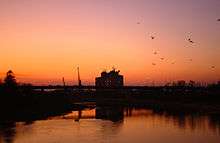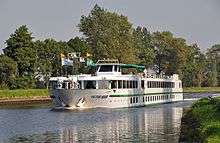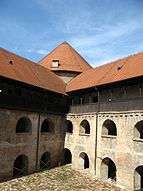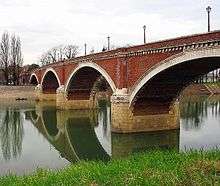Sisak
Sisak is a very important industrial and cultural city in Croatia. It's on three rivers: the Sava, Kupa and Odra. The Kupa flows through the old town. Sisak has about 50,000 inhabitants, with a metropolitan area of about 80,000.

Understand

Sisak is the biggest river port in Croatia. You can sail to Sisak with the Victor Hugo boat that sails from Budapest, Novi Sad, Belgrade and Slavonski Brod.
Get in
Sisak is a major hub of rail, roads, and river boating.
By train
Sisak is on Croatia's main railway line, which travels from Zidani Most in Slovenia to Zagreb and finally to Sisak, terminating at the grand 1880s railway building at the bottom edge of the centre of twon town. In addition to the numerous train services operate each day to Zagreb (including the new, high-speed tilt train which completes the journey in around 35 min), there are services to Novska and Rijeka. The Croatian Railways website has information on train times and tickets. The railway station is being renovated and modernised. Before the war there was a railway line that ran from Sisak and Karlovac, but that line was destroyed during the war.
By car
Main highways pass nearby to Sisak from Zagreb through to Belgrade, which is 24 km northeast of Sisak. Highway A11, which is under construction, passes from Zagreb to Sisak and will in the future be extended to the border with Bosnia and Herzegovina.
Driving to Sisak is easy with good signposting from all directions, and there is on-street as well as lot parking in the town.
Get around
The city has 12 districts: Centar - South, Centar - North, Centar - East, Centar - West, Zeleni Brijeg, Zibel, Tomćev put, Galdovo, Željezara, Vrbina, Naselje, Viktorovac.
You can see a lot of bikes paths in the center of city, you can easily use it.
Taxis serve the whole city and have colours of city, green and blue.
See
- Old Fortress, the old town is a fortress from the 16th century where took place the Battle of Sisak on June 22, 1593. The fort is a heritage site. From the Old Town to the city of Sisak is approximately 2 km by road or mile promenade.
 Inside of Fortress
Inside of Fortress - Siscia in Situ, the archeological park Siscia '' in situ '' - the remains of Roman architecture. Southwestern walls with tower from the late 2nd - early 3rd century, within the walls remains horreum - barns, built in the early 4th century.
 Siscia in Situ
Siscia in Situ - Old Bridge (Stari most), the first wooden bridge on the Kupa River was built in 1862, merged the Civil and Military Sisak (left and right banks of the river Kupa). In 1934 the brick bridge was built, which becsme one of the symbols of the city, and the locals call it the Old Bridge. This bridge is built from traditional materials Sisak, stone and brick.

- Sisak historic ring, next to the building of Mali Kaptol is set Sisak historic ring. Seven showcases, which are located below the floor level, presented the seven most important periods in the history of the city of Sisak.
- Promenade Slavo Striegl, the promenade is the heart of the city, a place to hang out, talk, here you can refresh yourself in one of the many cafes and enjoy the view of the river. In the 18th century here were located port facilities. A walk will encounter a steam crane, near the Capitol building Mali. It is a modernized river traffic and replace manpower. The combination of river and rail transport determine the development of the city in the 20th century.
- Mali Kaptol, is one of the oldest brick house was built in the Baroque period in the late 18th century; here is located Sisak jazz club, one of the most famous jazz clubs in the world in general. Mali Kaptol away from the Old Bridge about 500 meters.Mali Kaptol and the famous train
- Cathedral of the Exaltation of the Holy Cross, cathedral of the Exaltation of the Holy Cross - Church Diocese of Sisak, located at Ban Jelacic Square, next to the archaeological park "Siscia in situ". The present church was built in the first half of the 18th century. On 5 December 2009, Pope Benedict XVI, again founded Sisak Diocese under Bishop Vlado Kosic, and their former parish church of the Exaltation of the Holy Cross declared the cathedral.
- Veliki Kaptol, is one of the most valuable examples of architectural classicism in Sisak. It was built in 1830. In 1839 the first theater performance in Croatian stokavian, "Juran and Sofija" Ivan Kukuljevic Sakcinski or "Turks under Sisak", was held here. Big Capitol is located on Ban Jelacic Square in the vicinity of the Old Bridge. Since 2009, it has been the seat of the Diocese of Sisak.
- House Lieberman, house with a beautiful wrought iron. It was built in 1856 and was owned Sisak dealer Lieberman. It is the oldest Sisak Jewish family that moved to the city in the early 19th century. His fortune and reputation acquired in the trade with grain.
- Palace Grga Tuskan
- Music School Fran Lhotka / Sisak Synagogue, in the first half of the 19th century Sisak grew from a small village in an important trade center of Croatian and attracts people from various parts of the Habsburg Monarchy. The first Jews in Sisak come as merchants. Very fast becoming an important factor of economic development of the city and the synagogue was built between 1862 and 1890, their spiritual center. After World War II the synagogue was converted into a music school, which until now exists in this area.
Do
- Celtic Night, During the first days of September, when the moon is young, on the Promenade near the Kupa River, a natural gathering venue of citizens of Sisak and their guests, the ′Celtic Night′ happens. All along the left bank of the Kupa, on which the town centre abuts, between two bridges of Sisak, thousands of people get together to proudly revise a great history lesson in the open, on the river which has always meant life for the town of Sisak. In the glow of spotlights, walking with heroes, athletes, and leaders, with rich cultural and gastronomic offer, with playful laugh of a happy child..., with magic potion served to us along the bank on the Promenade by druids and sorceresses, there are pictures on floats emerging, connected with flowing candles, accompanied by music and a voice which clarifies, reminds and revives all that what is property and heritage of us all, each of the pictures being related to a great historical event, each with its story and its hero. Characters from books and legends, in their costumes and very special, precious possession of memory of the town of Sisak, in the light of the candles tell the ′Celtic Night′, that, what we are going to leave to the coming generations: glorious history of the town which has broken invaders, opposed the powerful but also has left a lasting memorial in the history of the Croatian people.
Buy
- There are numerous stores and bakeries in the city center (Mlin i Pekare, Konzum) and shopping malls (Interspar, Kaufland, Lidl, Billa, etc.).
Eat
- Mali Kaptol, restaurant. ☎ +385 (0)44 521-232
- Tri Jagode, caffe and bakery, order "burek" which is pastry with cheese, one of the best in this part of Balkan
Drink
- You can drink on the promenade, Riva caffe, Banana caffe, Zlatne godine etc..